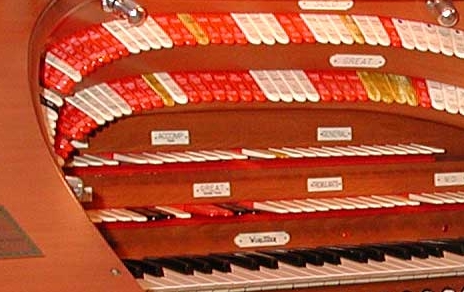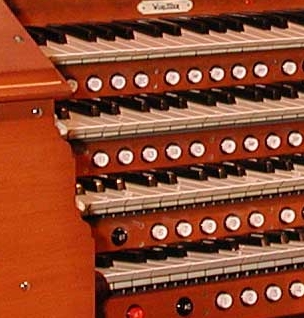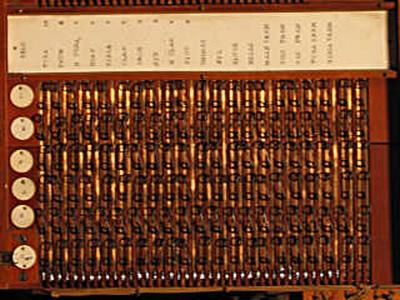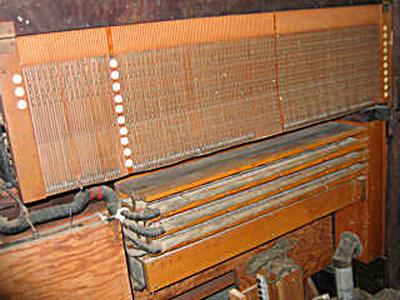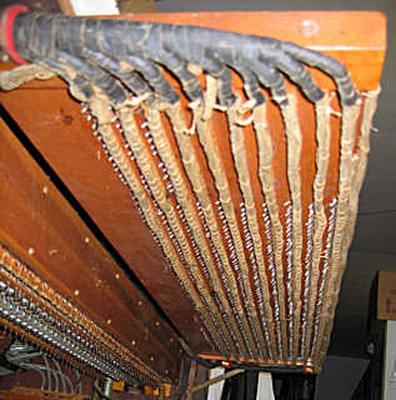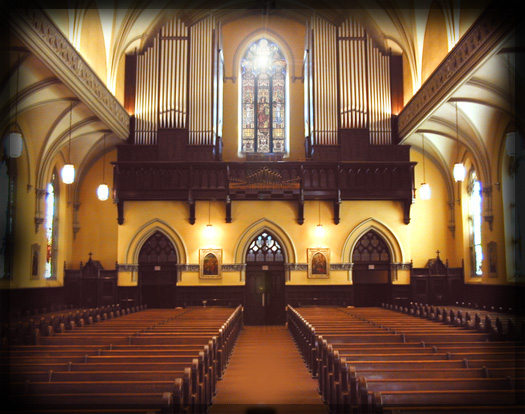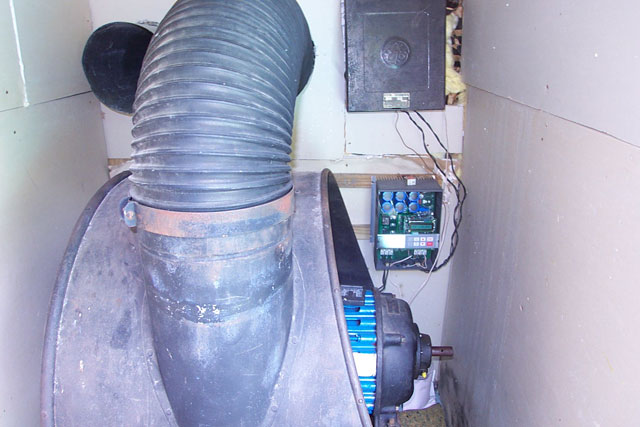
|
|
Church Organs and Theatre Organs are much alike, but there are marked differences.

A modern 6-manual draw-knob console controlling a huge Church Pipe Organ.
The Four Families Of ToneBoth instruments are made up of four basic families of pipes and these are:
If two ranks of Strings are installed as a pair on one stop and slightly detuned, we call this a Celeste. We also find Reeds and Flutes installed in Celeste pairs. We have even seen Diapason Celestes on some very large organs of both kinds. The Stop Controls and How They Work
The consoles of Theatre Pipe Organs have "Stop Tongues" arranged in a horseshoe around and above the manuals, and on the fallboard above the top manual. Most Church Pipe Organs have "Draw Knobs" arranged on angled side panels. These switches are used to turn on the various ranks of pipes, where each rank in the organ gets a draw knob or stop tongue engraved with the footage and name of the rank it controls. We have seen Church Pipe Organs with stop tongues, but the classical design uses the draw knobs. It is interesting to note that stop tongues take up much less space than draw knobs. Thus, the Theatre Pipe Organ packs a great deal of flexability in a relatively compact console. To "draw a rank", depending on the organ, one either pushes a stop tongue down or pulls a draw knob out. Some newer draw knob consoles use the "push-on push-off" draw knob, which lights up whenever it is "drawn". We see this a lot in the new digital organs. The Colors of the Stop Tongues
The four common stop tongue colors found The stop tongues on the Theatre Pipe Organ are multi-colored, where the ones on Church Pipe Organs are mostly white. Both machines use black stop tongues in the "Couplers", switches that allow a rank to play more than one note per key. On the Theatre Pipe Organ, red tongues control Reeds, mottled yellow ones control Celestes, and white ones get the Tibias, single Strings and Diapasons. We have seen green ones and blue ones on Tuned Percussions, but these two stop tongue colors are very rare, being found on only the largest of instruments. This color scheme was followed by most Theatre Pipe Organ builders except Moller. The American Guild of Organists set down a standard color scheme that included the four colors mentioned earlier and seen in the illustration above, but not before many Theatre Pipe Organs were built. Note that some electronic instruments, like the Rodgers and Conn Theatre Organs, had grey tongues for the percussions, but on the Theatre Pipe Organ, these were usually white. Lowrey, Gulbransen and Schober used green tongues for percussions. Thomas used blue ones. Kimball and Baldwin tried many combinations of stop tongue colors from year to year and model to model. Stop Tongue LabelsA stop tongue is engraved with the name of the rank it controls at the top of the tongue, with the footage (the longest pipe in the rank) below the name, and an abbreviation of the name near the leading edge of the tongue. If it is a Coupler, the path the Coupler takes is at the top, followed by the resultant footage, and an abbreviation below that such as Sub (one octave below the unison 8'), Off (turns off the actual unison 8'), and Oct (one octave above the unison 8'). It is worth noting here that an 8' rank of pipes has the same pitch at middle C as a piano note at middle C on the keyboard, hence the term "Unison". Stop Tablets
There are also to be found, on some organs, square rocker switches called "Stop Tablets" or "Tabs", that come on when one pushes down the front edge of the tablet. On the newer organs with stop tablets, whenever they are activated, they light up. If the stop tablets are mounted on the fallboard above the manuals, pushing the bottom edge of the tablet inward turns it on. Pushing the top edge turns it off. Church Pipe Organs have stop tablets on the fallboard or "back rail". Theatre Pipe Organs have stop tongues on the back rail. Most pipe organs of both kinds have narrow "key cheeks", the wooden boards on the ends of the manuals. Seldom do we see stop tablets installed there. We do, however, see pistons for sound effects and other things mounted in the key cheeks of a Theatre Pipe Organ. Many electronic church and theatre organs have stop tablets installed in "end blocks", flat wooden or plastic panels at the ends of the manuals. Others have the narrow key cheeks, like their pipe organ counterparts. Conn was notorious for using stop tablets in end blocks and on the back rail. Most small electronic home organs have no backrail and use the "end block with stop tablets" arrangement. Second TouchThe organ plays at the same volume no matter how hard the keys are struck, unlike the piano which gets louder when you play harder. Organs are best played with a light touch. Some organs have what we call "Second Touch", that is, when a key is pressed down to make a note, pressing a little harder causes a second stop to play. These stops are usually located on the fallboard above the top manual. On larger instruments, the bass pedals are also equipped with Second Touch. This is useful for a quick brass accent or other tonal change, where changing stops by hand or through presets would not be practical or appropriate for the piece being played. The Combination Action
Both the Theatre and Church Pipe Organs have what is referred to as a "Combination Action", which allows the organist to store presets containing various drawn stops, which are activated by pressing little buttons called "Thumb Pistons" that live below the manual keys or "Toe Studs" that live around the bass pedals. If the stops move when a piston or stud is pressed, we call this a "Moving Combination Action". If they do not, we call it a "Blind Combination Action". Almost all Theatre Pipe Organs have the Moving Combination Action, whereas most of their electronic counterparts have the Blind type. Only on the more expensive electronic machines do we find the Moving Combination Action. Setting CombinationsCombinations are usually set so that the quieter ones are on the lefthand end of the row of pistons, and the louder ones are on the righthand end. Each manual and the bass pedals get a set of "Divisional" pistons, some preset at the factory and others adjustable by the organist. There are also "General" pistons that comtrol the entire organ. And there are pistons that "cancel", or turn off, all the stops in a Division or the Generals. Finally, there are pistons for "setting", or programming, the combinations. Some of these settings are duplicated on the toe studs, but there are studs specific to the bass pedals. Below, Mighty MidiTzer creator Jim Henry gives us the lowdown on how the combination action works. We will quote Jim directly...
The first photo shows the spring wire switches used to set the combinations. There are two vertical brass strips for every stop tab on the console. There is a row of switches for every piston that can control the stop tabs. The switches can be set to one side so that pressing the piston for that row will set the stop or to the other side to clear the stop. The switch can also be set on top of the wood in the middle and then the stop will not be changed by the piston. The trems, which are controlled by the pistons for all of the manuals, are frequently set on the wood so they aren't changed by the pistons.
The second photo shows the Solo (third manual) portion of a WurliTzer 3/13 Style 240 setterboard from the LA Orpheum. The white strip at the top provides the stop labels for the columns. It is plastic and it looks like somebody really pounded on a manual typewriter to create the labels. More likely they had steel stamps for each stop label and pounded those into the plastic to create these strips. These strips provide some of the best evidence of what the original specification of an organ was because it is easy to see alterations to these strips. The round tags label each row as to the piston. On the 240 Solo you have 6 pistons controlling 14 Solo stops and 5 trems. This requires 6 x 19 or 114 switches just for the rather small Solo section. The Great and Accompaniment with 10 pistons each and more stops are much larger. Yes, I have dreamed about replacing the setterboards with a solid state combination action while standing wedged between the console and the stage with a flashlight in my teeth holding a sheet of settings in one hand and setting the board with the other.
The next picture shows the setterboard from my Style 215 console. The setter board for a Style 216 would look like this but would require even more columns because of the extra stops on the back rail. Here's the breakdown for a Style 216 setterboard:
......Pistons..Stops..Switches Great...10......40......400 Acc.....10......40......400 Pedal....3......14.......42 TOTAL...23......89......842 Most setterboards fit across the back of the consoles. Remember that while the Style 216 was the largest of the 2 manual consoles, it is still smaller than most 3 manual consoles. On the really big consoles that Ron alludes to, the setterboards had to be placed in the relay area because they wouldn't fit in the console.
The fourth picture shows the back of my 215 setterboard. The large bundle of wires wrapped in black tape seen at the top of the picture come from the electro-pneumatic relays that can be seen below the setterboard in the previous picture. There are three rows of relays with the signal wires coming out to the left forming the other end of the large tape wrapped wire bundle. There is one relay per piston. The relay provides one signal wire per stop tab controlled by the piston. Every switch on the setterboard is fed by an individual wire coming from the piston relays. Each brass strip is connected to a wire at the bottom of the setterboard. These are seen at the right of the picture of the back side and they are collected in a bundle at the right side of the board, barely visible in the distance. The wires coming from the setterboard, two per stop, go to electromagnetic valves that actuate the pneumatic mechanism to move the stop tabs. There are two pneumatic actions when you press a piston. First the relay bellows are inflated to close the piston relay. Then the stop blow box pneumatics are actuated to move the stop tabs. This creates a distinctive thump-thump sound when you press a piston on a Wurlitzer console. So there you have it. More than you ever wanted to know about electro-pneumatic combination actions and setterboards in a Wurlitzer console. And do notice that all of this is stuffed, and I do mean STUFFED, inside the console! The same kind of arrangement is found again in the relay rack in the pipe chambers to deal with the stop closures and key presses to send the signals to control the pipes. That relay is too big to include in the console. Pipe Cases
Church Pipe Organs have some their pipes, calle the "Facade", out in the open in huge ornately decorated "Pipe Cases" mounted on the walls around the sactuary where space is not at a premium and the pipes can clearly be seen, as in the beautiful 1928 E. M. Skinner instrument in the picture above. If you want a really good look at the pipe cases of Church Pipe Organs around the world, head over to the website John Foss created known as Organs and Organists Online. There, you will find pictures, stop lists, and free downloads of many great songs performed on the world's greatest instruments. John is also the owner of two wonderful Yahoo! newsgroups, Organ Uploads and Organists Off Topic, where organ enthusiasts can chat and share music. We highly recommend joining these groups. Pipe Chambers
The Theatre Organ's pipes are enclosed behind movable wooden or metal motor driven shutters, known as "Swell Shades". This is so that their loudness can be controlled, from whisper quiet to earth shaking loud. These shutters are placed at the front of the rooms full of pipes, otherwise known as the "Chambers". The pipes of a Theatre Pipe Organ have to be placed in as little space as possible. Thus, it is seldom that they are ever installed out in the open like the facade pipes in a Church Pipe Organ. Swell Shoes
Below the manuals, in the center of the panal above the bass pedals lives one or two, perhaps three or more volume pedals (depending on the size of the instrument) that resemble the gas pedal of an automobile. These are activated by the organists right foot. As the organist pushes the volume pedals, called "Swell Shoes" down, the Swell Shades open to let more sound out. There is a Swell Shoe for each Chamber. Pipes behind Shades are said to be "under expression". When the Shoes are up, one can still hear the organ but it is very soft. When the Shoes are down all the way, the Shades are open wide and the organ is very loud. Since pipes always play at full volume, this is the only way to control them. The ones that are out in the open, like those in the Church Pipe Organ facade, play at full volume, and are said to be "unenclosed". The other pipes in the cathedral organ live behind the Facade inside the Cases (which also have Swell Shades.) The Crescendo ShoeOn alnost all pipe organs there is a special additional pedal called a "Crescendo Shoe" that works with the Combination Action so that the quieter combinations are drawn with the pedal up, and as it is pushed down, louder combinations come into play. The Crescendo Shoe has a special "Setter Board" that is wired by the factory or an organ voicing technician to select the combinations it will draw. Stops that are already drawn outside a combination are not affected, so that the Crescendo Shoe adds to what is playing as it is pushed down. When it is up, only stops previously drawn are left playing. When the pedal is all the way down, we call this "Full Organ", where the instrument is as loud as it will be with most of the ranks playing. This pedal is to the right side of the Swell Shoes and is slightly offset so that it is less likely to be stepped on by mistake. On some instruments there is a row of lights in the fallboard that gives the organist a visual representation of where this shoe is resting along its travel. Windage
In the Theatre Pipe Organ, the Chambers necessitate more power from the blowers but, since all the pipes are enclosed, the organist has a great deal more control over the overall loudness. There are fewer pipes in a Theatre Pipe Organ, but they are bigger in circumferance. Since the pipes of a Theatre Pipe Organ are under more air pressure, they are much louder. The Church Pipe Organ plays at lower air pressure. This is one reason more ranks are needed to reach power. There is a Swell Shoe for each "Division", or group of ranks, related to a manual or the bass pedals. In a sense, Church Pipe Organs are an assemblage of many smaller pipe organs playable from one large console. Theatre Pipe Organs do not have divisions. They are instead divided among the chambers. Above each stop tongue is a marker denoting which chamber that particular rank of pipes lives in. The TremulantsIn both kinds of pipe organs, we find stop controls labelled "Tremulants". By using a special valve in the air supply that rapidly raises and lowers the pressure in the chest, a vibrating effect is heard as the pitch and volume of the effected pipes changes. The Tremulant adds beautiful warmth and emotion to the tone of the pipe organ. The Tremulants on the Theatre Organ pipes are much more pronounced. Sound EffectsThe Theatre Pipe Organ has sound effects like horses hooves, door bells, sirens, train whistles and bird calls, along with drums and cymbals. Not only did the Theatre Pipe Organ have to set the mood of the silent movie, it also had to provide sound effects. Today, these are used to create many novalty effects in modern musical arrangements. The Church Pipe Organ has no need for these sound effects. It must blend in with the choir instead. To do this, more or less ranks are drawn, depending on the arrangement of the music and the size of the choir. UnificationWhen pipes share notes through Couplers, manuals or divisions, we call this "Unification". Church Pipe Organs have much less Unification than their cinema organ counterparts, although we are seeing newer cathedral organs becoming more unified. The Church Pipe Organ has a pipe for every note and a rank for every stop. This is another reason Church Pipe Organs have many more pipes than the Theatre Pipe Organ, which can use the same pipe in many different places throughout the organ. Take, for example, a rank of Tibias on a Theatre Pipe Organ, where the longest pipe in the rank is 16 feet in length and there are 97 pipes in the rank. This 16' pipe can sound on the lowest C note of any manual or the bass pedals. The rank can also sound on several notes at the same time from one key using Couplers. There can be stops (depending on the size of the instrument) at 16', 10-2/3', 8', 5-1/3', 4-1/7', 4', 3-1/5', 2-2/3', 2', 1-3/5, 1-1/3', and 1' pitches, for a total of up to twelve notes, all sounding from just one key or pedal played! We have seen other less common footages on really huge instruments. The Tibias usually have the most stop tongues per rank. Other ranks rely on the Couplers. The notes, if played at middle C, would be C, G, C, G, B, C, E, G, C, E, G, C and would make a nice fat C Major7 chord spanning four octaves. Imagine grabbing a three-note chord with all twelve of these stops drawn. There would be three chords with a combined total of thirty-six notes playing! Now, let's say you put these same stops down on two manuals and play a chord in the same place on both manuals and the root note of the chord on a bass pedal. There would still be only thirty-seven notes playing, because the manuals and bass pedals are sharing the rank (the pedal adds one more note when played on a lower octave outside the chord.) On a Church Pipe Organ, there would be 73 pipes ringing out across three ranks, since the stops or manuals do not share a rank. Unification in this manner is one of the major sticking points with church organists concerning Theatre Pipe Organs used in litergical music. It is also why a Theatre Pipe Organ is difficult, if not impossible, to get in perfect tune relative to the keys being played. This "out-of-tune-ness" is one of the things that give the Theatre Pipe Organ what theatre organists call "that sweet sound". Unification in a Church Pipe Organ is usually limited to Couplers, allowing a rank to be available in more than one pitch. The larger instruments also have intramanual couplers at several pitches that allow multiple divisions to be played from one manual. This makes the pipes easier to tune, and it is also what gives the Church Pipe Organ what church organists call "awesome majesty and power". |
